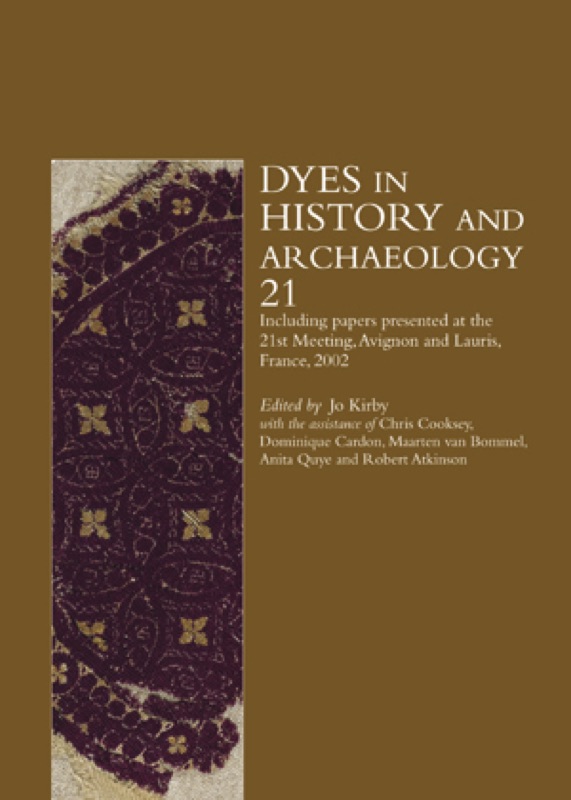The trade in dyestuffs has played an important role in the economic history of many nations. In medieval Europe this is demonstrated by the important place held by woad in the economy of many countries, but while the woad industry of Toulouse or Erfurt is quite well known, that of Catalonia and Roussillon is rather less familiar. Other aspects of medieval woad dyeing are equally interesting: it is known that the vat contains indigo-reducing bacteria, but how do these bacteria interact with the indigo to make the process work? In fact, identifying the dye present in fragments of aged or degraded textile or in a tiny pigment sample is only half the battle: we are still left wondering how the effects revealed by the analysis were achieved. Thus, madder was widely used in Roman and Coptic Egypt, but which madder? How do the red pigments used to paint the sumptuous glazes on 15th- or 16th-century European paintings relate to the textiles dyed with the same dyes?
Some classes of works of art present particular problems because no sample may be taken or because the materials used in the construction of the object are poorly understood or particularly intractable. Many Japanese objects of cultural heritage can only be studied by non-invasive methods, but sometimes this study can be greatly assisted by even a limited amount of analysis, as demonstrated by the discussion of braids used in Japanese armour. The organic pigments used in illuminated manuscripts present a similar problem as they are often difficult to identify by non-invasive methods. Some, such as the anthocyanin blues and exotic dragonsblood, are also not particularly well characterised while others, such as the expensive shellfish purple also found on Roman and Coptic textiles, are tantalisingly rare.
These topics are among those discussed in the papers presented at the 21st Meeting of Dyes in History and Archaeology, held in Avignon in 2002, together with discussions on a range of topics from theoretical studies of alizarin complexes to the use of logwood as a biological stain and the use of dyes in West Africa and 18th-century Poland.
Editorial
Max Saltzman: a recollection
Contributors
Dye analysis of selected textiles from three Roman sites in the eastern desert of Egypt: a hypothesis on the dyeing technology in Roman and Coptic Egypt
Jan Wouters, Ina Vanden Berghe, Ghislaine Richard, Rene Breniaux and Dominique Cardon
Dyestuff analysis of two textile fragments from late antiquity
Regina Hofmann-de Keijzer and Maarten R. van Bommel
A new HPLC-PDA method for the analysis of Tyrian purple components
Zvi C. Koren
The biblical dye tekhelet and its use in Jewish textiles
I. Irving Ziderman
Indigo-reducing bacteria from the medieval woad (Isatis tinctoria L.) vat: some aspects of their interaction with indigo
Philip John, Stylianos Arghyros and Sonja Nicholson
Woad production in Catalonia and Roussillon at the end of the Middle Ages
Anthony Pinto
The identification of purple in manuscripts
Cheryl Porter
Missal blue: anthocyanins in nature and art
Maria Joao Melo
Sanguis draconis, dragon's blood: the use and analysis of a manuscript illuminators' colorant
Arie Wallert and Maarten R. van Bommel
Some aspects of medieval and renaissance lake pigment technology
Jo Kirby
Monitoring of Damage to Historic Tapestries (MODHT): a newly initiated EU project
Anita Quye, with an Addendum by Kathryn Hallett
Dye analysis of braids used for Japanese armour dating from the 14th to the 16th centuries (poster presentation)
Yoshiko Sasaki, Masanori Sato, Mari Omura and Ken Sasaki
Chromatographic and spectroscopic differentiation of insect dyes on East Asian paintings (poster presentation)
Jennifer Giaccai
A study of model carminic acid lakes prepared using cochineal, collagen and different mordant salts
Valery Golikov and Zoe Zharikova
Natural dyes used in Polish workshops in the 17th and 18th centuries
Katarzyna Schmidt-Przewozna
Archaeology and dyeing traditions in West Africa (poster presentation)
Marie Marquet
Chinese green: experimental investigations (poster presentation)
Christopher J. Cooksey, Alan T. Dronsfield and Jo Kirby
Logwood under the microscope
Brian H. Davies
Edward Schunck: forgotten dyestuffs chemist?
Christopher J. Cooksey and Alan T. Dronsfield
Spectroscopic studies (FTIR, SIMS, ES-MS) on the structure of anthraquinone-aluminium complexes (poster presentation)
Jana Sanyova
Computation of a visible light absorption spectrum, a semi-empirical quantum mechanical approach: application to the colour determination of alizarin complexes in solution or chemisorbed onto cellulose
Francois Delamare and Bernard Monasse
Evaluation of consolidants for black iron tannate-dyed Maori textiles (poster presentation)
Rangi Te Kanawa, Gerald J. Smith, Glenn A. Fenton, Ian J. Miller and Cara L. Dunford
In the circle of colour: natural dyeing of flax, silk and wool (poster presentation
Katarzyna Schmidt-Przewozna and Witold Przewozny
